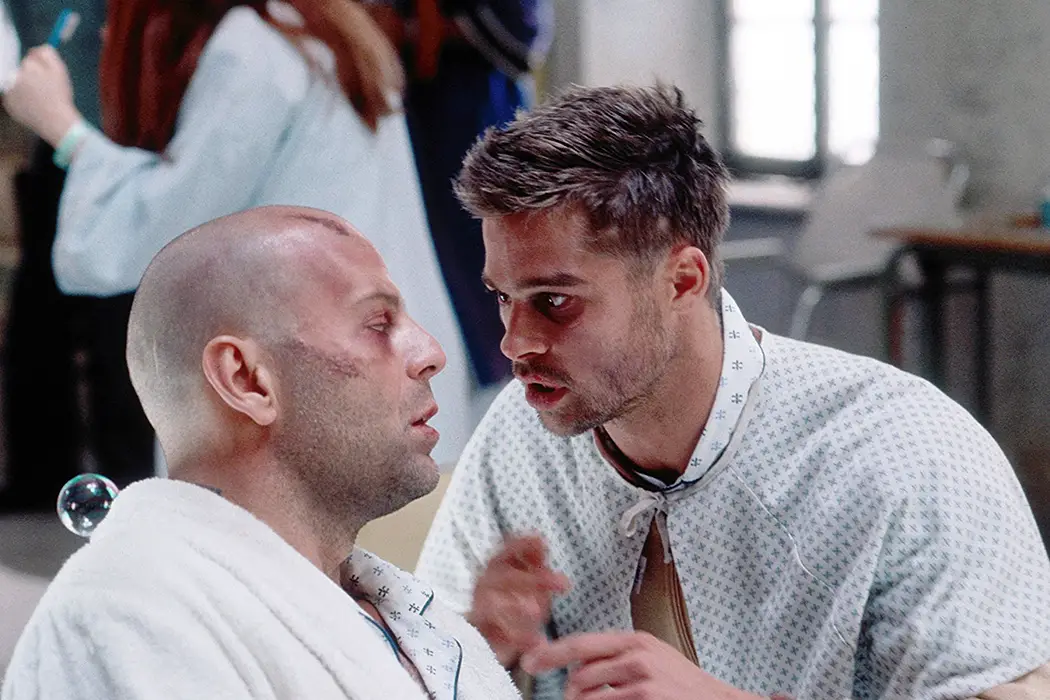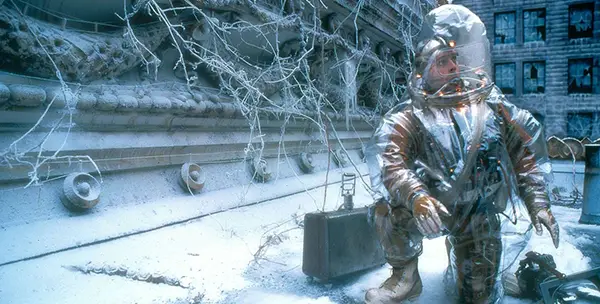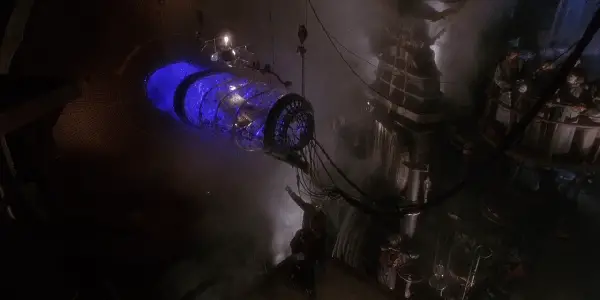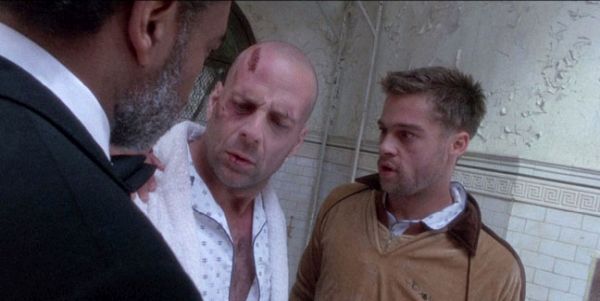Time Crisis: TWELVE MONKEYS

Christine is a software engineer currently working in the animation…
In our last installment of Time Crisis, we talked about questions of the self through the literal and figurative fracturing of identities in Shane Carruth’s indie time travel drama Primer. This month we’re broadening the discussion to our experience of time throughout our lives and how it connects to our perception of reality. To do this, we’re going to dive into an often overlooked late twentieth-century entry to the genre: director Terry Gilliam’s Twelve Monkeys.
Twelve Monkeys: Gilliam’s Other Dystopian Epic
Twelve Monkeys wasn’t Gilliam‘s first foray into time travel – the Monty Python alum had already explored the genre’s comedic possibilities in 1981’s Time Bandits, his second feature as a writer-director. Bandits was about a group of time-traveling dwarves who jump around history looting treasure.
Time travel aside, Twelve Monkeys has more in common with Brazil, Gilliam’s first and more well-known dystopian sci-fi film – both feature men trapped in systems that they are powerless to change. But unlike Brazil, over which Gilliam famously exerted total creative control, Twelve Monkeys was a collaborative effort – it was written by David and Janet Peoples. The writing team brought serious sci-fi chops to the table, David having co-written Blade Runner.

The script was based on a 1962 French short subject called La Jetée – a film composed almost entirely of still photographs set to voiceover dialogue and music. While the Peoples’ script added more layers to the plot, the basic facts of the story remain true to the source material. Gilliam, who still hadn’t seen La Jetée when production began, filled out the world of Twelve Monkeys with his surrealistic visual flair.
The story centers around a post-apocalyptic future in which a pandemic virus has killed most human life. A small number of surviving people have retreated to an underground colony, leaving animals to reclaim the surface of the earth. Among those still alive is James Cole (Bruce Willis), a prisoner who is forced to explore the outside world in a hermetically sealed suit, collecting samples of plant and insect life. Because of his adeptness at this task, he is chosen to be sent back to 1996 using a still experimental method of time travel.
His mission is to locate a pure sample of the decimating virus, in order for scientists to develop a cure. The scientists make a slight miscalculation in their time machine calibrations, landing him in 1990 instead. There he is promptly arrested and put in a mental hospital alongside Jeffery Goines (Brad Pitt), an actually crazy guerrilla animal rights activist.
Time Travel In Twelve Monkeys
As with Primer, the way that time travel functions within the story will be a key factor in forming an understanding of the film’s themes, so let’s get into it.
In order to jump back in time, a naked Bruce Willis is suspended in what looks like a giant plastic water bottle, from which he is expelled into a huge turbine-like contraption as dozens of lab-coated scientists monitor the proceedings on various industrial instruments. He then appears (roughly) at the year specified by the operators. The actual arrival in the past is not shown on screen, and there’s even less of an explanation about the return trip. From the perspective of other people who see Cole in the past, he just appears and disappears out of nowhere.

The actual mechanism of time travel isn’t important in Twelve Monkeys – the narrative rules aren’t inherent to the user interface. The time machine itself is just a vehicle for Gilliam’s whimsical retro-industrial visuals.
Time travel in Twelve Monkeys has one important rule: the basic events of the timeline cannot be changed by the time traveler. This rule isn’t obvious, but it’s supported consistently by the text of the film. Cole’s mission is pure reconnaissance – there’s never any expectation that his actions in the past will be able to prevent the plague from happening. Cole tries to explain this to the doctors at the mental hospital:
“Save you? How can I save you? It already happened! I can’t save you. I’m simply trying to get some information for people in the present so that someday…”
The Prison of Time
At the beginning of this series we talked about the human experience of feeling trapped in time as a driving force in the creation of time travel fiction. Gilliam and the Peoples’ double down on this feeling in Twelve Monkeys, making Cole’s life an inescapable endless loop. Although James Cole travels back and forth in the timeline, he’s unable to alter his own life or prevent the tragedy of billions of people dying in the pandemic. All he can do is what he’s been tasked to do – create a chance at a better future for what’s left of humanity. As in real life, no one can change what has already happened. The only difference is that in the fiction of the film, what’s already happened can include the future.
An illustrative scene occurs when Cole and his psychiatrist-turned-accomplice Kathryn Railly (Madeleine Stowe) are hiding out in a theater playing Alfred Hitchc*ck’s Vertigo. The pair watch the scene in which Kim Novak’s character traces the duration of her lifetime on the cross-section of an ancient pine tree. Cole is transfixed by this – he remembers seeing the film as a child, remarking: “The movie never changes, it can’t change. But every time you see it it seems different because you’re different.”
Time travel allows Cole to rewind and replay his life like a film, but he isn’t writing the script. His companion responds to his realization with what might be considered the film’s thesis statement: “If you can’t change anything because it’s already happened, you may as well smell the flowers”.

We can see that Gilliam is building on an idea explored earlier in his filmography – in Brazil, industrialized society is a prison that can only be escaped by imagination. In Twelve Monkeys, time itself is the prison.
Can We Know What’s Real?
Another of time travel fiction’s strengths is its ability to explore the way we perceive reality. In our everyday lives, the present is the only frame of reference that’s considered real. We can remember our past and imagine our future, but we’re constantly encouraged to “live in the present moment”, embracing the only tangible reality available to us. And despite differing points of view, we can all (ideally) agree on what basic facts constitute this reality.
But traveling to the past puts Cole into a position where his reality – that of the civilization being at its end – is suddenly vastly at odds with the reality of everyone around him. Society doesn’t tolerate this type of discrepancy for long – Cole is labelled as mentally deviant and thrown in a mental hospital for his declarations of future disaster.
Cole is initially confidant that what he knows about the future is real, but he soon learns that everyone else in the hospital is equally convinced of the validity of their own constructed realities. As one patient puts it:
“I find myself on another planet, Ogo, part of an intellectual elite, preparing to subjugate barbarian hordes on Pluto. But even though it’s a totally convincing reality in every way…I can feel, breathe, hear…nevertheless, Ogo is actually a construct of my psyche. I am mentally divergent in that I am escaping certain unnamed realities that plague my life here.”
Cole logically concludes that his experience of living in a post-pandemic future might well be a construct of his psyche. The idea even seems appealing – it’s an escape from the nightmare of his life. But the film doesn’t lead us to conclude that he’s simply hallucinating – Cole’s experience is corroborated by others, and we never get an ambiguous spinning top moment like in Inception or other films that aim to make viewers question the actuality of what they just saw.
Still, we can recognize that there’s not much separating Cole’s perception of reality from that of the guy who thinks he’s from the planet Ogo. We believe Cole, but the story would function in more or less the same way if he was imagining the whole thing. Twelve Monkeys ultimately leaves us wondering what’s scarier: the fact that we might not be able to tell what’s real, or the knowledge that it might not even matter.
What are you thoughts on Twelve Monkeys?
Does content like this matter to you?
Become a Member and support film journalism. Unlock access to all of Film Inquiry`s great articles. Join a community of like-minded readers who are passionate about cinema - get access to our private members Network, give back to independent filmmakers, and more.
Christine is a software engineer currently working in the animation industry. Hates Ferris Bueller's Day Off, Loves Star Wars. Writes at hackingcinema.com













